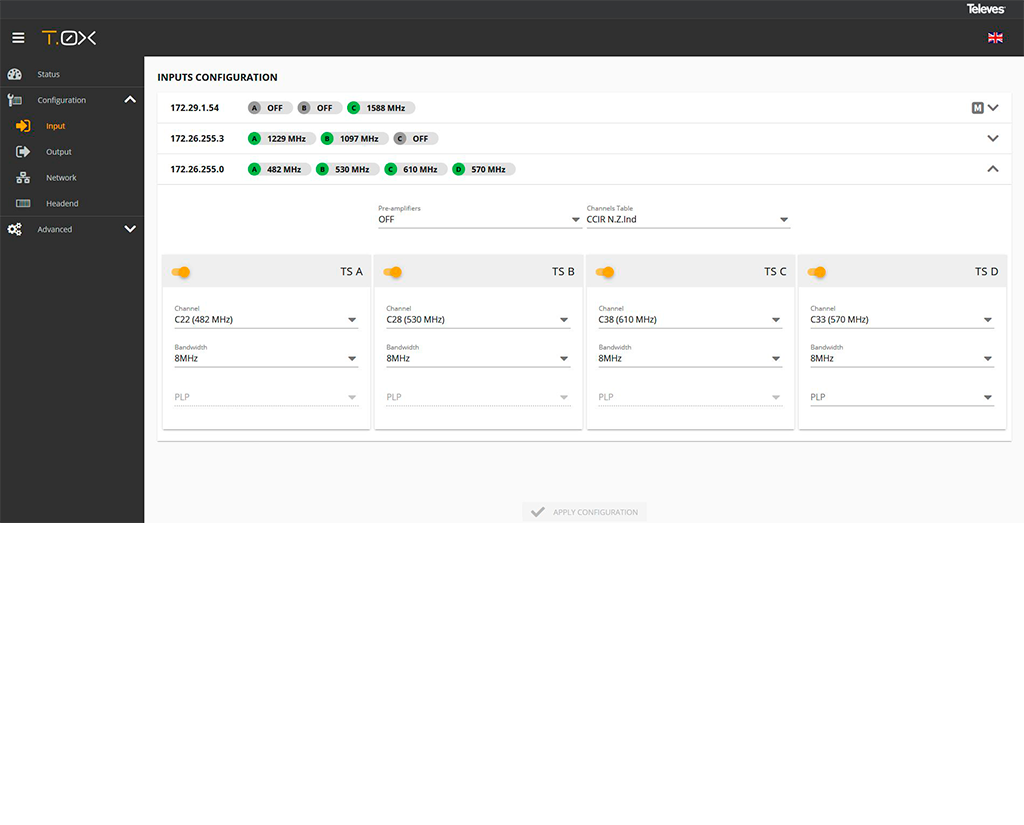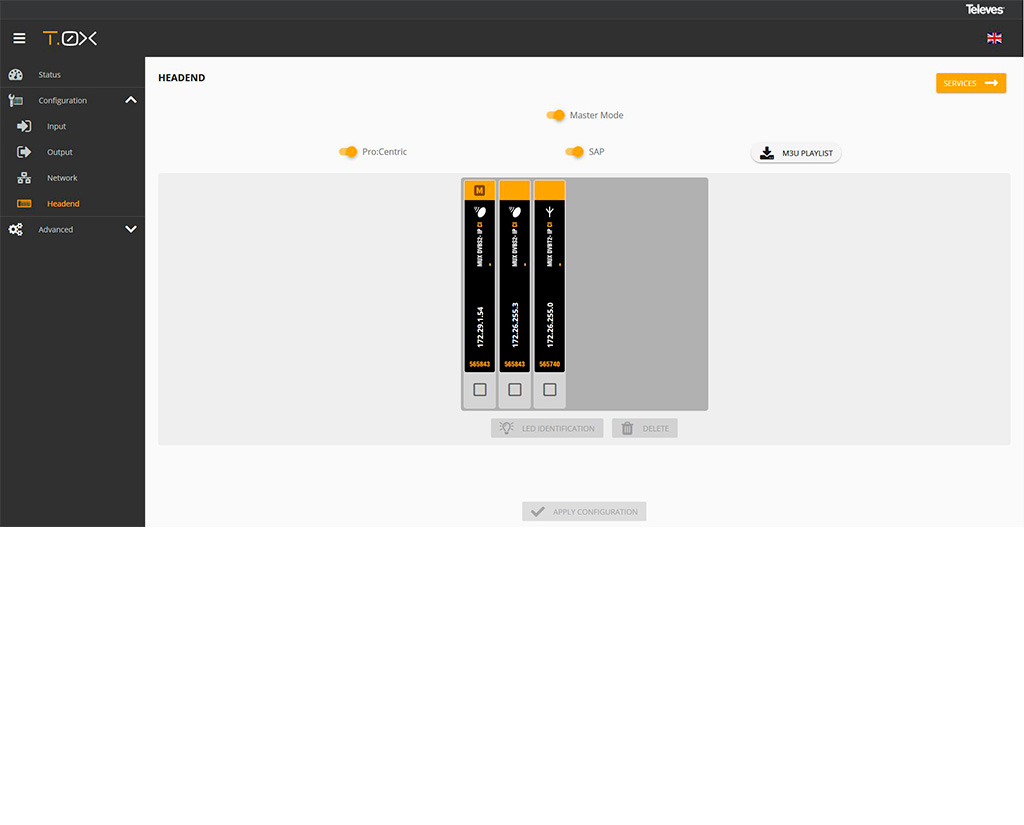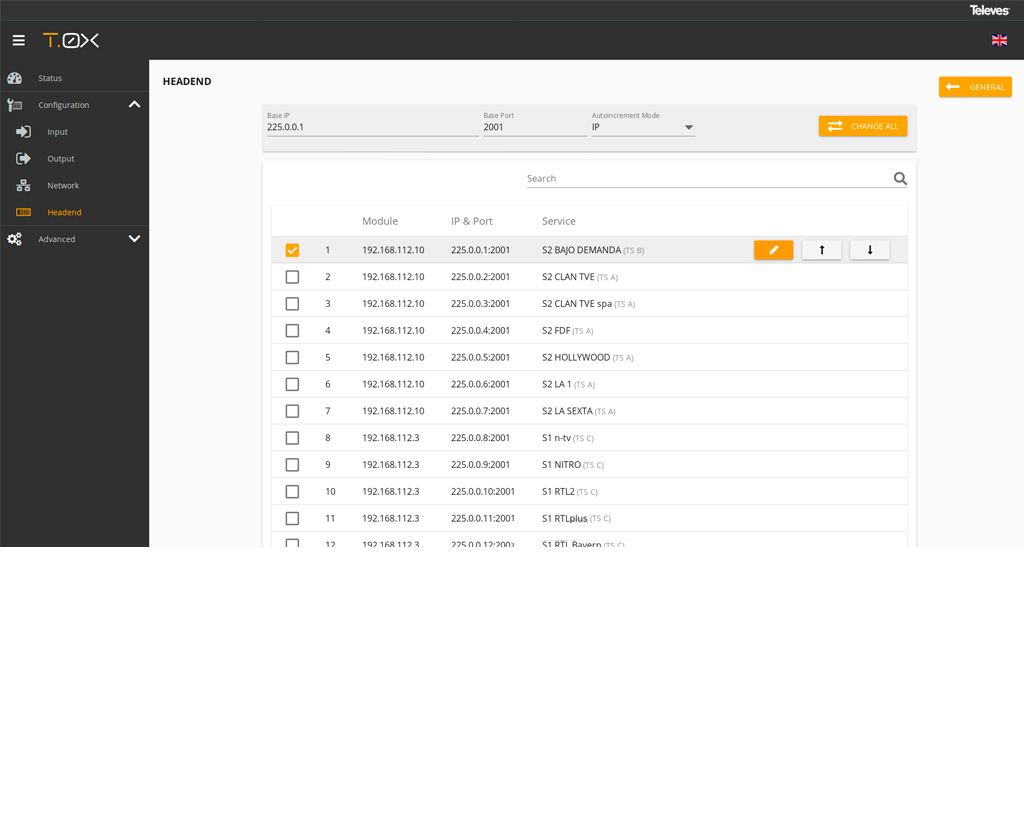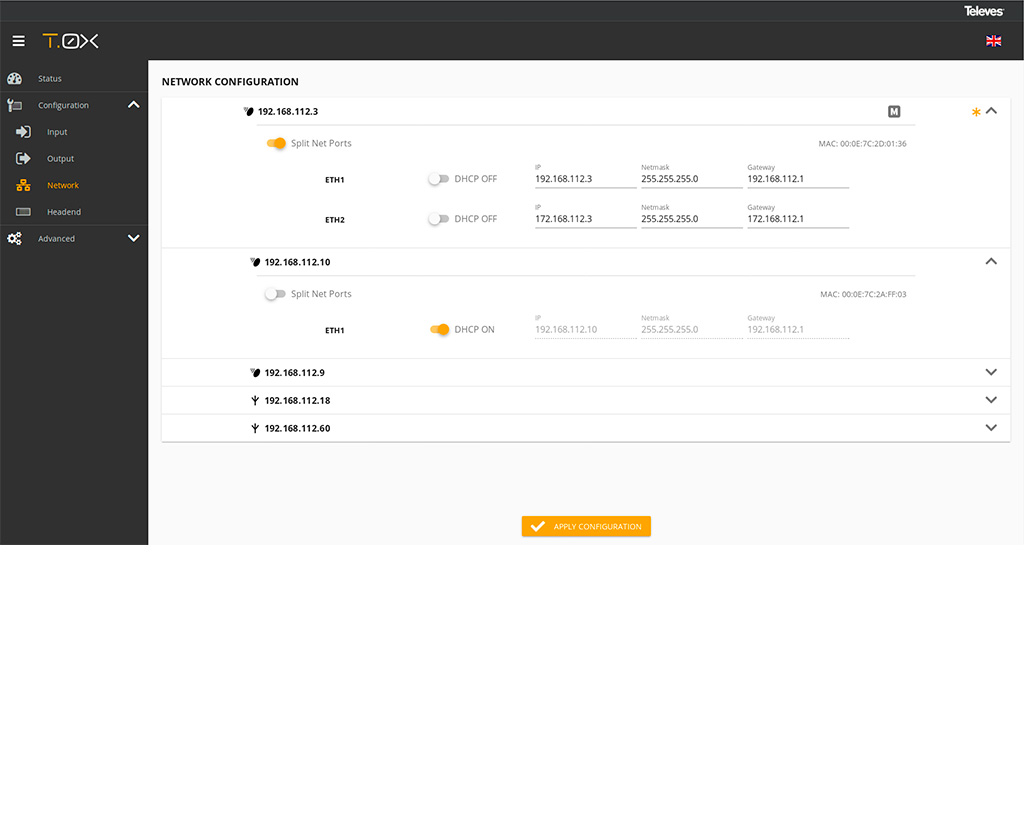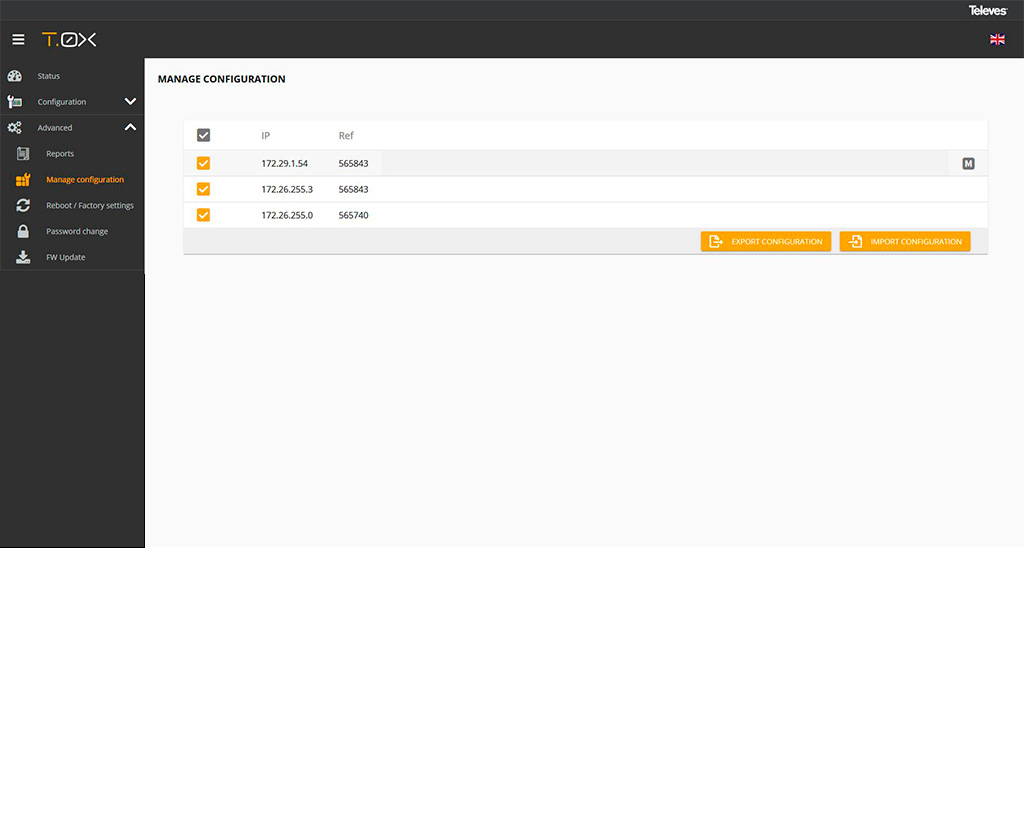Streamer with remultiplexing DVBT/T2 - IP, with CI and Pro:Idiom Re-encrypt
Streamer generating an IP encapsulated output from the multiplexing of the services available in 4 different DVB-T or DVB-T2 muxes.
The encrypted satellite channels are transformed into free IP services through the CI interface and the appropriate CAM module. Depending on the CAM type used (standard/professional), one or several services may be opened for free visualization.
The module has the option to re-encrypt the IPservices decrypted by the CAM with a DRM Pro:Idiom solution (Digital Rights Management),for secure delivery of contents.
The system will encompass a power supply and some streamer modules depending on the number of services to be distributed.
- 32 IP streams SPTS
- DiSEqC 1.0 for multiswitches control
- Service decryption by insertion of a PCMCIA module
- DRM (Pro:Idiom) encryption of the output IP streaming
- Access to the headend configuration through a self-created WiFi network (using the kit with ref.216802)
- Internal switch for IP out Daisy chain of serveral modules
- External to the headend services signaling, such as those coming from a HE-21 headend
- Equipment monitoring using basic SNMP protocol, which allows behavior values to be indicated through the network (network information, unit turn-on times, etc ...)
- Selection of services among the 4 input muxes to distribute in streaming
- Includes EPG information (Electronic Program Guide) in the headend output stream
- Provides flow information of each service to estimate the global output flow of the module
- Device monitoring and signal status LEDs
- Embedded user web interface for module configuration:
- Configuration of the entire headend selecting one of the module as a master
- Automatic detection of the modules that are connected to the master
- Cloning function to replicate configurations between modules and headends
- UDP or RTP output protocol selection, for greater compatibility with IPTV sistems
- Headend control indicators: module temperature, CAM status
| Input frequency range | MHz | 150 ... 862 |
|---|---|---|
| Frequency steps | MHz | 125 ... 166 |
| Input level | dBm | -60 ... -20 |
| Input impedance | Ω | 75 |
| Through losses | dB | < 1.5 |
| Bandwidth DVB-T | 6 MHz / 7 MHz / 8 MHz | |
| Bandwidth DVB-T2 | 1.7 MHz / 5 MHz / 6 MHz / 7 MHz / 8 MHz | |
| VSWR Min | 10.0000 | |
| Powering per preamps | Vdc | 12 ... 24 |
| DRM Pro:Idiom | Yes | |
| Max. number of services Pro:Idiom | 8 | |
| IP-Ausgang Modus | Multicast / Unicast | |
| IP protocol | IPv4 / DHCP / UDP/RTP | |
| IP streams SPTS | 32 | |
| Data rate | Mbps | 150 |
| Service signaling | M3U / Pro:Centric / SAP / Tizen | |
| Powering | Vdc | 24 |
| Max. current consumption (Module) | mA | 500 |
| Max. current consumption (CAM) | mA | 100 |
| Max. current consumption (Preamp) | mA | 100 |
| Current consumption | mA | 700 |
| RF connectors | "F" female | |
| Data connector type | RJ-45 Gb Ethernet | |
| Protection index (IP) | 20 | |
| Operating temperature | °C | 0 ... 45 |
Physical data
Net weight: 755 g
Gross weight: 1,000 g
Width: 50 mm
Height: 217 mm
Depth: 175 mm
Main product weight: 755 g
Packing
Box 1 Units
| tlv_discontinued | No | |||||||||||||||||||||||||||||||||||||||||||||||||||||||||||||||||||||||||||
|---|---|---|---|---|---|---|---|---|---|---|---|---|---|---|---|---|---|---|---|---|---|---|---|---|---|---|---|---|---|---|---|---|---|---|---|---|---|---|---|---|---|---|---|---|---|---|---|---|---|---|---|---|---|---|---|---|---|---|---|---|---|---|---|---|---|---|---|---|---|---|---|---|---|---|---|---|
| tlv_reflog | U4CIP-CI-PRO | |||||||||||||||||||||||||||||||||||||||||||||||||||||||||||||||||||||||||||
| tlv_tabla_especificaciones |
|
|||||||||||||||||||||||||||||||||||||||||||||||||||||||||||||||||||||||||||
| tlv_ean | 8424450209752 | |||||||||||||||||||||||||||||||||||||||||||||||||||||||||||||||||||||||||||
| tlv_dim_product_x | 50 | |||||||||||||||||||||||||||||||||||||||||||||||||||||||||||||||||||||||||||
| tlv_dim_product_x_label | Width | |||||||||||||||||||||||||||||||||||||||||||||||||||||||||||||||||||||||||||
| tlv_dim_product_x_unit | mm | |||||||||||||||||||||||||||||||||||||||||||||||||||||||||||||||||||||||||||
| tlv_dim_product_y | 217 | |||||||||||||||||||||||||||||||||||||||||||||||||||||||||||||||||||||||||||
| tlv_dim_product_y_label | Height | |||||||||||||||||||||||||||||||||||||||||||||||||||||||||||||||||||||||||||
| tlv_dim_product_y_unit | mm | |||||||||||||||||||||||||||||||||||||||||||||||||||||||||||||||||||||||||||
| tlv_dim_product_z | 175 | |||||||||||||||||||||||||||||||||||||||||||||||||||||||||||||||||||||||||||
| tlv_dim_product_z_label | Depth | |||||||||||||||||||||||||||||||||||||||||||||||||||||||||||||||||||||||||||
| tlv_dim_product_z_unit | mm | |||||||||||||||||||||||||||||||||||||||||||||||||||||||||||||||||||||||||||
| tlv_weight_product_label | Main product weight | |||||||||||||||||||||||||||||||||||||||||||||||||||||||||||||||||||||||||||
| tlv_weight_product | 755 | |||||||||||||||||||||||||||||||||||||||||||||||||||||||||||||||||||||||||||
| tlv_weight_product_unit | g | |||||||||||||||||||||||||||||||||||||||||||||||||||||||||||||||||||||||||||
| tlv_gross_weight_label | Gross weight | |||||||||||||||||||||||||||||||||||||||||||||||||||||||||||||||||||||||||||
| tlv_gross_weight | 1,000 | |||||||||||||||||||||||||||||||||||||||||||||||||||||||||||||||||||||||||||
| tlv_gross_weight_unit | g | |||||||||||||||||||||||||||||||||||||||||||||||||||||||||||||||||||||||||||
| tlv_net_weight_label | Net weight | |||||||||||||||||||||||||||||||||||||||||||||||||||||||||||||||||||||||||||
| tlv_net_weight_unit | g | |||||||||||||||||||||||||||||||||||||||||||||||||||||||||||||||||||||||||||
| tlv_net_weight | 755 | |||||||||||||||||||||||||||||||||||||||||||||||||||||||||||||||||||||||||||
| tlv_1_type_pack | Box | |||||||||||||||||||||||||||||||||||||||||||||||||||||||||||||||||||||||||||
| tlv_1_type_pcs_pack | Units | |||||||||||||||||||||||||||||||||||||||||||||||||||||||||||||||||||||||||||
| tlv_1_pcs_pack | 1 |
Remultiplexing of services
The unit has four demodulators (TS A, TS B, TS C, TS D), connected to a single signal input. The unit always operates in loop mode.
Programming of the entire headend selecting one of the module as a master
Configure one of the modules as a master of the entire headend. Any module can be selected as the master. Once the master mode is activated, the unit searches for other units connected to the network (ETH2).
The units can be visually ordered in the web interface to identify them more easily with the real position in the headend. Each of the modules can be identified by temporarily activating the flash of the front LED.
Multiple addition of services
Multiple services can be added at once by selecting one base IP address and one base port, such as the wanted services, and an IP address or port auto-increment The web interface will automatically generate rhe IP multicast addresses of each of the services, in terms of the selected parameters.
Separated networks in each module
Each unit has two Ethernet RJ45 connectors, which can be used on an single network or on two separate networks, one for control and the other for video distribution. Users can be enable the separation of these networks (Split Net Ports) and configure the IP address, subnet mask, and default port link, as well as the DHCP client mode.
Cloning of headends configurations
The web interface allows to export/import files for duplicating units (or complete headends) configurations. This function helps to reduce time in typical installations, due of having previously a configured file. The exportation of these files also allows to have a headend configuration backup.
-
Declaration of Conformity
DOC01200001_0_565740.pdf
(0.21 MB) -
End-User License Agreement
EULA11220003_PDF - English_565801_565840_565701_565740.pdf
(1.77 MB) -
End-User License Agreement
EULA11220003_PDF - Español_565801_565840_565701_565740.pdf
(1.76 MB) -
AutoCAD drawing
565740_CAD02230256.dwg
(0.3 MB) -
Technical specifications
technical_specifications_en_US_TEC04250079_565740.pdf
(0.11 MB) -
Product Sheet
565740_en_US_product_sheet_PSH01232317_565740.pdf
(0.33 MB) -
User Manual
MUS12190012_003_565701_565740_565801_565840.pdf
(4.75 MB)




